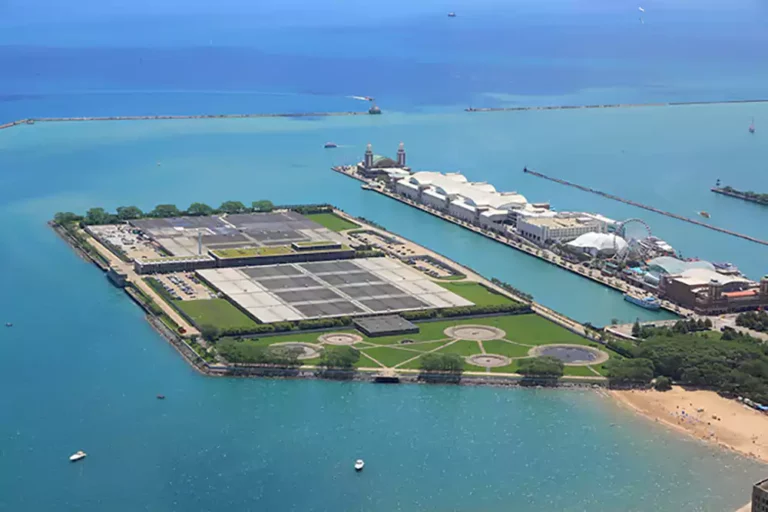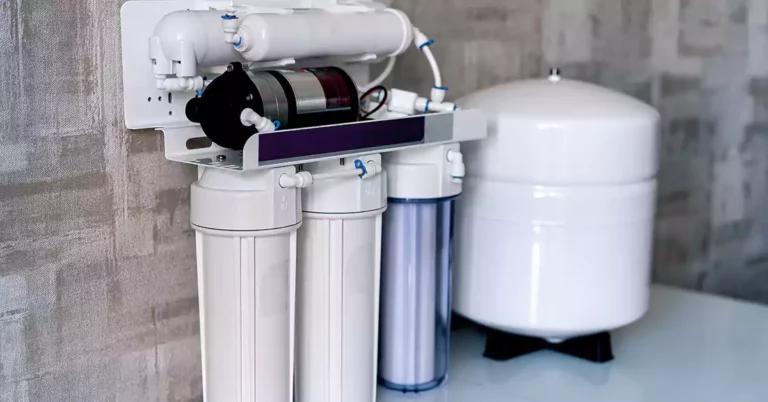PFAS Chemicals in Your Drinking Water: The Danger of Forever Chemicals
There’s something lurking in your drinking water, and it’s not just bacteria and minerals. PFAS chemicals are becoming more common in water supplies around the world, and many people don’t even know what they are. This chemical contaminant is concerning — these “forever chemicals” are linked to a variety of health problems.
If you are concerned about dangerous PFAS chemicals in your drinking water, here’s what you need to know.
What Are PFAS Chemicals?
PFAS chemicals, also known as per- and polyfluoroalkyl substances, are a group of manmade chemicals used in thousands of consumer products. These manmade chemicals were introduced in 1946 by DuPont. As of 2021, the Environmental Protection Agency (EPA) has identified over 12,000 PFAS chemical variants[1].

Polyfluoroalkyl substances are long-lasting and hardly degrade in the natural environment which is why they are called “forever chemicals.” Because of the widespread use and persistent nature of PFAS, a 2007 study found PFAS levels in >98% of the population sampled[2]. Most alarming, the non-degradable nature means PFAS tend to bioaccumulate within humans and animals.
Despite the permanent environmental contamination and health risk posed by PFAS, industries continue using PFAS chemicals to produce everyday products.
Forever Chemicals Found Across Industries
PFAS chemicals are found in consumer, commercial and industrial products. Chemical companies such as DuPont, 3M, and Chemours manufacture products with toxic PFAS chemicals.
The most well-known products are Teflon cook pans; any type of “non-stick” cookware most likely contains a PFAS variant.
Consumer Products
PFAS are more widespread than any consumer realizes. The non-profit Chemtrust notes that PFAS are used due to “their ability to repel both grease and water”[3].
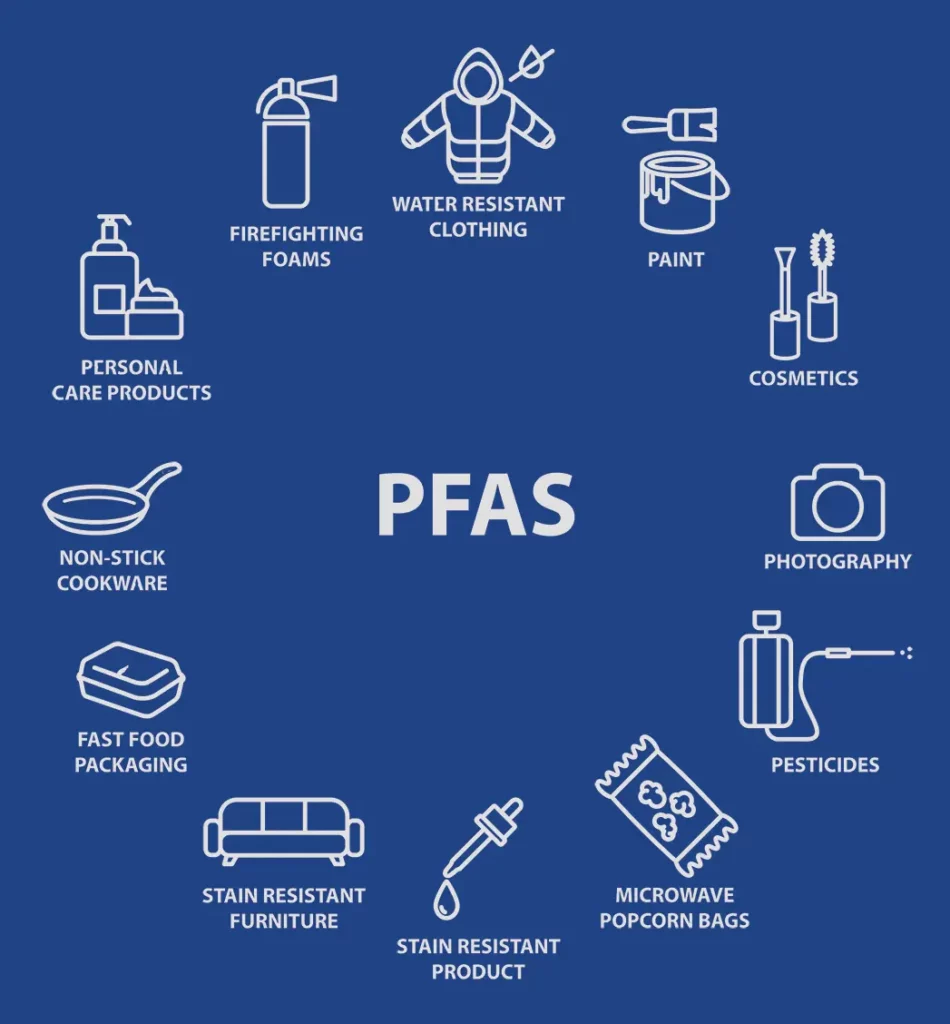
These PFAS-contaminated consumer-grade products include everyday items such as:
These types of products are found in most homes around the United States and contribute to PFAS exposure for consumers around the United States.
Non-profit groups and state agencies, like the Environmental Working Group (EWG) and the Food & Drug Administration (FDA), have completed studies to determine whether products still use PFAS.
EWG developed SkinDeep, a tool to learn about the toxic chemicals in common personal care products[4]. The FDA completed a study on food production and food packaging to determine PFAS pollution[5]. These tools mark a shift in PFAS legislation; non-profits and governmental agencies are taking steps to tackle PFAS pollution due to its harmful health effects.
Industrial Products
PFAS compounds are also used in commercial and industrial settings. These chemicals are often found in industrial firefighting foam. This means a concentration of PFAS pollution can be found near airports and military bases where liquid fuel-based fires can occur more often.
Firefighting foam most notably creates contaminated soil which slowly seeps into groundwater. Industry production also releases PFAS into the atmosphere and soil which contaminates water sources and food supply.
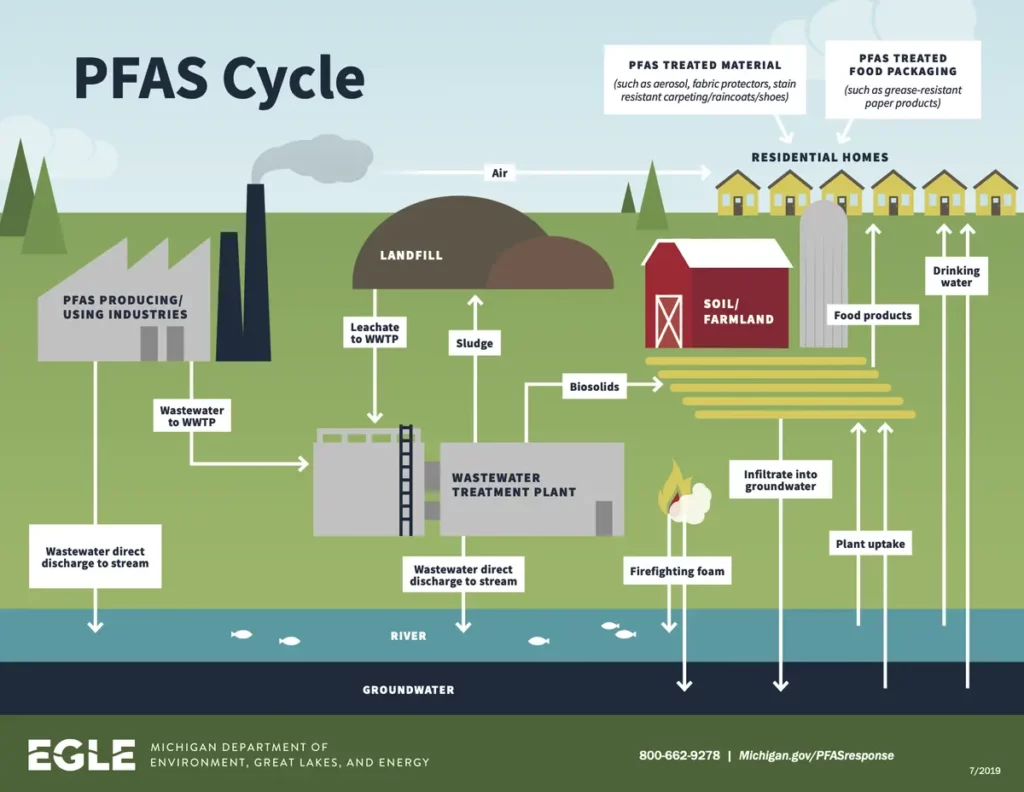
The continued use of PFAS chemicals has contaminated water systems across the globe. PFAS exposure whether through drinking water or food supply has negative health effects.
Pervasive PFAS Contamination in Drinking Water
Forever chemicals have invaded the natural environment. In landfills all around the world, discarded fast-food wrappers, cook pans, and old mattresses leach chemicals. All of these PFAS products are seeping toxic chemicals into the ground, air, and water.
Contaminated sites include everywhere from the soil, surface water, the atmosphere, the deep ocean, and most alarmingly, the human body[6]. Not even bottled water is safe. Natural spring water brands are also contaminated with PFAS[7].
The wide-scale exposure to polyfluoroalkyl substances is a public health crisis.

PFAS Exposure Potential
Water and PFAS-containing products are the most common methods of exposure to PFAS. The EWG has developed an interactive map showing PFAS contamination across the United States. Similarly, EWG has a tool to check all the potential contaminants that pose a health risk in your local water[8].
Unfortunately, PFAS are odorless and tasteless, so without a water test, it’s impossible to know if your water supply contains these toxic substances. The potential health effects are not worth the risk.
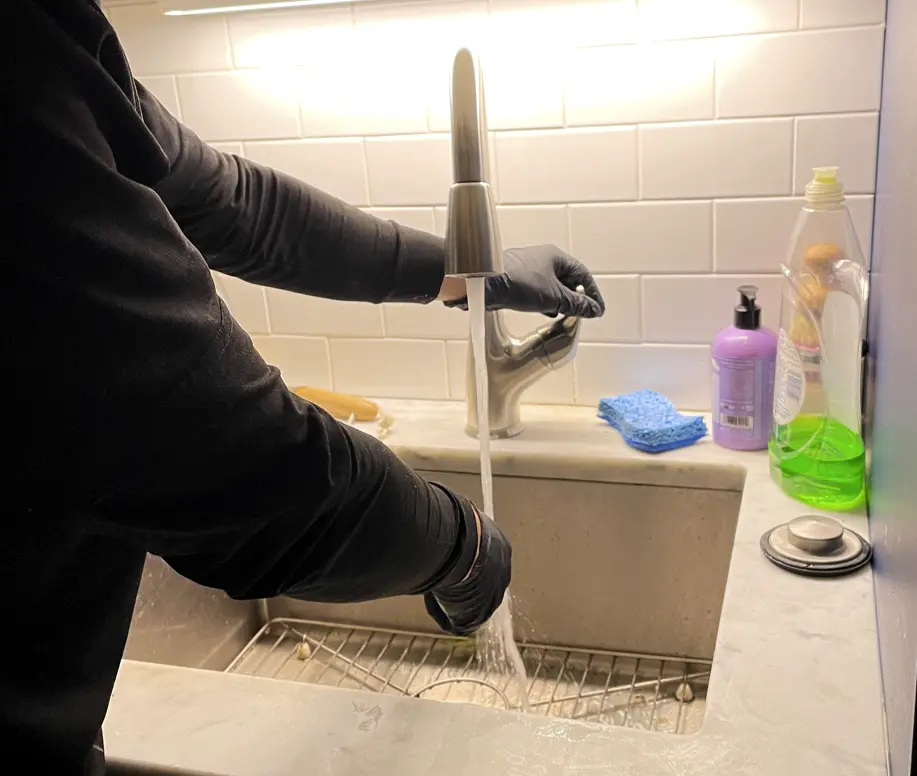
Dangerous Health Effects Caused by Exposure to Toxic Chemicals
In June 2022, the EPA updated the drinking water advisory. With new scientific studies, the EPA concluded that new science indicates “that some negative health effects may occur with concentrations of PFOA or PFOS in water that are near zero and below EPA’s ability to detect at this time”[9]. PFAS, even in very small doses, can cause harm to humans.
The Centers for Disease Control (CDC) monitors PFAS as a toxic chemical due to human health effects on the immune system, thyroid function, and reproduction[10]. The health concern around per and polyfluoroalkyl substances ranges from cancers to birth defects.
Health Risks
Bioaccumulation associated with PFAS chemicals means that the chemical can affect every part of the body. PFAS can pass the blood-brain barrier[11], and even be passed from a mother to an infant through breast milk[12].
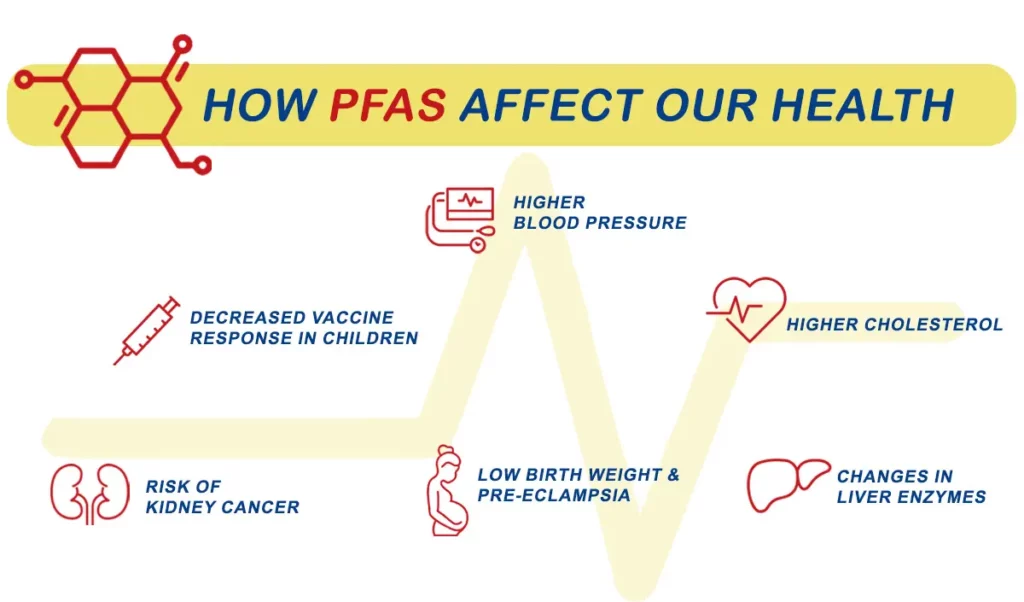
The Agency for Toxic Substances and Disease Registry, a sub-agency of the CDC, lists the possible human health effects[13]:
As more variants of polyfluoroalkyl substances are created, more research is completed on the effects of the chemicals on the human body. The National Institute of Environmental Health Sciences routinely publishes new scientific research[14].
PFAS Manufacturers Responses
With increasing studies proving the damaging effects of PFAS on the human body and the natural world, citizens and non-profits have called PFAS manufacturers to stop production.
As of June 2022, DuPont has committed to phasing out the use of long-chain PFAS chemicals though without a target date[15]. Chemours, the PFAS company that spun off Dupont, pledges to eliminate “at least 99% of PFAS air and water emissions” by 2030[16]. That said, Chemours also considers fluoropolymers and F-gases a necessity, despite the fact that both chemicals are in the PFAS chemical family.
Disappointingly, the company 3M has denied the recent science about PFAS pollution in drinking water supplies and the food supply. Instead, 3M has cited a study from 2014 that claims no “negative health outcomes” caused by exposure[17].
It is not enough to rely on the chemical industry to ban PFAS or cease the production of new PFAS. Take steps today to protect your health from these forever chemicals.

The Future of PFAS
Exposure to PFAS chemicals may seem inevitable. But government agencies and scientists have taken steps to prevent PFAS contamination around the world. The most recent 2022 study on the harmful effects has spurred governmental action to ban PFAS production.
Governmental Policies
In 2022, the EPA released a Strategic Roadmap to reduce PFAS in the U.S.[18]. The EPA’s initiative is backed by $10 billion in funding provided by the Bipartisan Infrastructure Law[19]. The Biden Administration also released a statement on PFAS promising to expand EPA and FDA research[20].
A bill to ban PFAS from food containers is currently in the House Energy and Commerce Committee[21]. These initiatives are designed to protect human health. However, it can be years before bills pass into law and for the chemical companies to adhere to new standards.

Scientific Advancements
Scientists are developing solutions for these forever chemicals.
Chemist Elsie M. Sunderland calls PFAS “the chemical whack-a-mole” with one variant replacing a previous chemical structure just as quickly as legislation can be put in place[22]. This means chemical alternatives need to be developed to replace the use of PFAS in products like fire-fighting foams and water-resistant fabrics.
Scientists continue to research options to save our environment from extensive PFAS pollution. Recent research conducted by Northwestern University found a simple method to break down the strong carbon-fluorine bond[23]. This bodes well for the future, degrading the chemical compound could reduce these ‘forever chemicals’ to benign atoms.
While scientists and government agencies work to ban PFAS and protect public health, citizens must take action to limit exposure to PFAS.
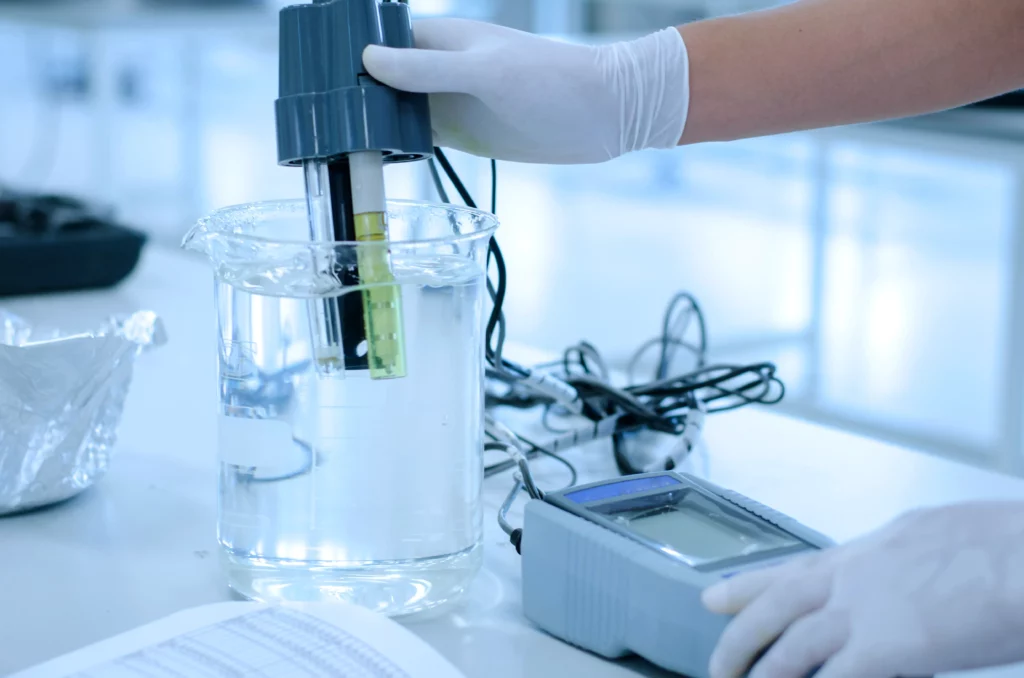
How to Protect Your Drinking Water from PFAS Contamination
Don’t wait to take action to protect your health from exposure to harmful chemicals. First and foremost, reduce exposure to PFAS by buying certified PFAS-free products. Most importantly though, avoid drinking unfiltered tap water. Water filtration is crucial for preventing PFAS-related illness.

Water Filtration
Water filters are an effective way of reducing PFAS chemicals in your drinking water. However, not every filter can remove these forever chemicals. A 2020 study concluded that the most effective type of water filter is a reverse osmosis system with a carbon filter[24].
Rescue Plumbing offers one of the few reverse osmosis systems that is certified by the IAPMO[25]. Novo Water’s Aqua Flo Platinum Quick Change Reverse Osmosis can remove both PFOA and PFOS variants[26].
Our water quality experts can provide a free in-home water test so you can decide what type of filter is best for your home. Call us to schedule a water filtration estimate at (773) 799-8848!
@rescueplumbing We can’t ignore dangerous PFAS in Chicago’s drinking water forever. Learn how you can reduce your exposure to these forever chemicals today! #FilterYourWater #WaterQuality ♬ My Heart Will Go On (Titanic) – Maliheh Saeedi & Faraz Taali
FAQs
Resources
[1]: U.S. Environmental Protection Agency. 2021. “CompTox Chemicals Dashboard.” Comptox.epa.gov/Dashboard/Chemical-Lists/Pfasmaster. August 10, 2021. https://comptox.epa.gov/dashboard/chemical-lists/pfasmaster.
[2]: Calafat, Antonia M., Lee-Yang Wong, Zsuzsanna Kuklenyik, John A. Reidy, and Larry L. Needham. 2007. “Polyfluoroalkyl Chemicals in the U.S. Population: Data from the National Health and Nutrition Examination Survey (NHANES) 2003–2004 and Comparisons with NHANES 1999–2000.” Environmental Health Perspectives 115 (11): 1596–1602. https://doi.org/10.1289/ehp.10598.
[3]: CHEMTrust. 2019. “PFAS – the ‘Forever Chemicals.’” CHEM Trust. December 11, 2019. https://chemtrust.org/pfas/.
[4]: Environmental Working Group. 2008. “Skin Deep® Cosmetics Database | EWG.” Ewg.org. Environmental Working Group. 2008. https://www.ewg.org/skindeep/.
[5]: U.S. Food & Drug Administration. 2022. “Analytical Results of Testing Food for PFAS from Environmental Contamination.” FDA, November 2022. https://www.fda.gov/food/chemical-contaminants-food/analytical-results-testing-food-pfas-environmental-contamination.
[6]: Sneed, Annie. 2021. “Forever Chemicals Are Widespread in U.S. Drinking Water.” Scientific American. January 22, 2021. https://www.scientificamerican.com/article/forever-chemicals-are-widespread-in-u-s-drinking-water/.
[7]: Felton, Ryan. 2019. “Some Bottled Water Brands Have Concerning PFAS Levels, Massachusetts Regulator Warns.” Consumer Reports. July 12, 2019. https://www.consumerreports.org/bottled-water/bottled-water-brands-with-concerning-pfas-levels-a6560338667/.
[8]: Environmental Working Group.. 2010. “EWG’s Tap Water Database: What’s in Your Drinking Water?” Ewg.org. Environmental Working Group. 2010. https://www.ewg.org/tapwater/.
[9]: U.S. Environmental Protection Agency. 2022. “EPA Announces New Drinking Water Health Advisories for PFAS Chemicals, $1 Billion in Bipartisan Infrastructure Law Funding to Strengthen Health Protections.” Www.epa.gov. June 15, 2022. https://www.epa.gov/newsreleases/epa-announces-new-drinking-water-health-advisories-pfas-chemicals-1-billion-bipartisan.
[10]: Centers for Disease Control and Prevention. 2019. “Per- and Polyfluorinated Substances (PFAS) Factsheet | National Biomonitoring Program | CDC.” Www.cdc.gov. May 24, 2019. https://www.cdc.gov/biomonitoring/PFAS_FactSheet.html.
[11]: Wang, Jinghua, Yitao Pan, Qianqian Cui, Bing Yao, Jianshe Wang, and Jiayin Dai. 2018. “Penetration of PFASs across the Blood Cerebrospinal Fluid Barrier and Its Determinants in Humans.” Environmental Science & Technology 52 (22): 13553–61. https://doi.org/10.1021/acs.est.8b04550.
[12]: Agency for Toxic Substances and Disease Registry. 2022. “PFAS and Breastfeeding | ATSDR.” Www.atsdr.cdc.gov. August 4, 2022. https://www.atsdr.cdc.gov/pfas/health-effects/pfas-breastfeeding.html.
[13]: Agency for Toxic Substances and Disease Registry. 2020. “Potential Health Effects of PFAS Chemicals | ATSDR.” Www.atsdr.cdc.gov. June 24, 2020. https://www.atsdr.cdc.gov/pfas/health-effects/index.html.
[14]: National Institute of Environmental Health Sciences. 2018a. “Perfluoroalkyl and Polyfluoroalkyl Substances (PFAS).” National Institute of Environmental Health Sciences. 2018. https://www.niehs.nih.gov/health/topics/agents/pfc/index.cfm.
[15]: DuPont. 2022. “Milestones.” Www.dupont.com. June 1, 2022. https://www.dupont.com/pfas/milestones.html.
[16]: Chemours. n.d. “PFAS Stewardship | the Chemours Company.” Www.chemours.com. Accessed December 12, 2022. https://www.chemours.com/en/corporate-responsibility/sustainability-safety/our-commitment-to-pfas-stewardship.
[17]: 3M. n.d. “Home.” 3M PFAS. Accessed December 12, 2022. https://pfas.3m.com/?utm_medium=redirect&utm_source=vanity-url&utm_campaign=www.3m.com/3M/en_US/pfas-stewardship-us/health-science/.
[18]: U.S. Environmental Protection Agency. 2021. “PFAS Strategic Roadmap: EPA’s Commitments to Action 2021-2024.” Www.epa.gov. October 14, 2021. https://www.epa.gov/pfas/pfas-strategic-roadmap-epas-commitments-action-2021-2024.
[19]: ———. 2022. “EPA’s PFAS Strategic Roadmap: A Year of Progress.” Www.epa.gov. October 2022. https://www.epa.gov/system/files/documents/2022-11/PFAS%20Roadmap%20Progress%20Report_final_Nov%2017.pdf.
[20]: Biden-Harris Administration. 2021. “FACT SHEET: Biden-Harris Administration Launches Plan to Combat PFAS Pollution.” The White House. October 18, 2021. https://www.whitehouse.gov/briefing-room/statements-releases/2021/10/18/fact-sheet-biden-harris-administration-launches-plan-to-combat-pfas-pollution/.
[21]: Dingell, Debbie. 2021. Keep Food Containers Safe from PFAS Act of 2021. https://www.congress.gov/bill/117th-congress/house-bill/6026.
[22]: Jones, Benji. 2022. “You Probably Have ‘Forever Chemicals’ in Your Body. Here’s What That Means.” Vox. August 25, 2022. https://www.vox.com/2022/8/25/23318667/pfas-forever-chemicals-safety-drinking-water.
[23]: Morris, Amanda. 2022. “‘Forever Chemicals’ Destroyed by Simple New Method.” News.northwestern.edu. August 18, 2022. https://news.northwestern.edu/stories/2022/08/forever-chemicals-destroyed-by-simple-new-method/.
[24]: Herkert, Nicholas J., John Merrill, Cara Peters, David Bollinger, Sharon Zhang, Kate Hoffman, P. Lee Ferguson, Detlef R. U. Knappe, and Heather M. Stapleton. 2020. “Assessing the Effectiveness of Point-of-Use Residential Drinking Water Filters for Perfluoroalkyl Substances (PFASs).” Environmental Science & Technology Letters 7 (3): 178–84. https://doi.org/10.1021/acs.estlett.0c00004.
[25]: International Association of Plumbing and Mechanical Officials. n.d. “Drinking Water Systems Certification.” Www.iapmort.org. Accessed December 12, 2022. https://www.iapmort.org/certification-services/drinking-water-systems-certification/.
[26]: NOVO Water Conditioning Products. n.d. “Aqua Flo Platinum Quick Change Reverse Osmosis.” Novo Water Conditioning Products. Accessed December 12, 2022. https://www.novowater.com/qcro-qcuf.




